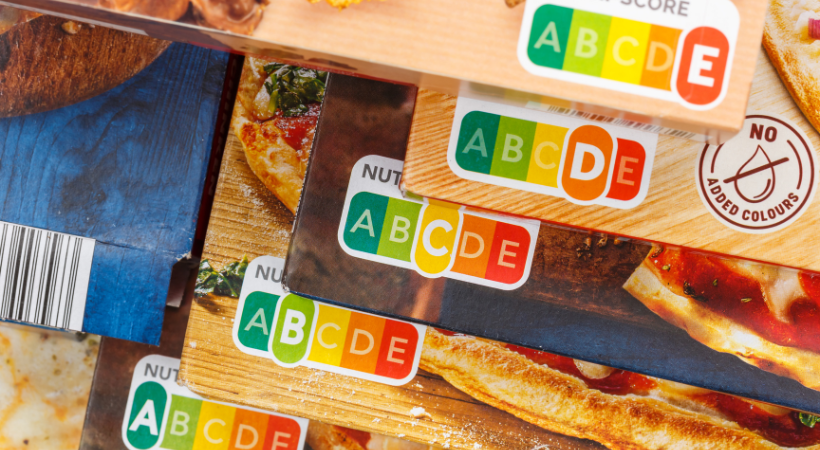What Information Has to be on a Food Label by Law?
What Information Has to be on a Food Label by Law?
Consumers rely on food labels to provide them with vital information about products that they intend to buy or have already purchased. This information, required by law, keeps people safe and helps them to make informed decisions about whether to buy and consume a food product or not.
Food Business Operators (FBO’s) and retailers are responsible for compliance, so if you make and sell food or drink products, it’s crucial you’re aware of what needs to be shown according to food labelling regulations. Some leave product compliance until the end of their development journey, however this can lead to problems and costly changes to packaging before launch.
Below, we explore the mandatory information required to be displayed on food and drink labels by law.
What information is legally required on a food label?
Use the jump links below to navigate to each section:
- Name of the Food
- Net Quantity/Weight
- Durability Indication
- Ingredients List
- Storage Conditions
- Nutritional Declaration
- Country of Origin
- Food Business Operator
- Declaration of Alcoholic Content
- Cooking & Preparation Instructions
Name of the Food
The name of the food is an essential piece of information that must be included on all labels. The name should be clear and descriptive, accurately reflecting the nature of the product and must not be misleading. The following are different types of product names:
- Names required by law
- Customary names
- Descriptive names
Names required or protected by law must be used where applicable. This includes products with legal compositional standards such as jam and milk chocolate, as well as names with reserved descriptions such as beef burgers.
The name of the food shall be its legal name, such as Milk Chocolate or Raspberry Jam. In the absence of such a name, the name of the food shall be its customary name. These are names that are commonly used and understood by consumers and are names which have been accepted over time. Customary names need no further explanation, such as toad in the hole, fish fingers, Yorkshire puddings and flapjack.
In the absence of legal or customary names, descriptive names must be given. The descriptive name must be a true reflection of the food and be clear enough for consumers to distinguish it from other foods it might be confused with. Descriptive names can be used to support a customary name and should include any characterising ingredients. Most food products will fall into this category, such as cooked basmati rice served with cooked chicken pieces in a spicy tomato sauce.
Accurate naming of the food product helps consumers understand what they are purchasing, preventing misunderstandings or confusion about the product.
Net Quantity / Weight
All pre-packed foods must be sold by quantity unless an exemption applies. This information allows consumers to compare the weight and price of different food products, enabling them to make informed purchasing decisions. As with all labelling, the quantity information must be accurate, clear and easy to understand to not mislead the consumer. The quantity information must be in the same field of vision as the name of the food.
The units that should be used are litres, centilitres, millilitres, kilograms, or grams as appropriate. Food products packed in a liquid or glaze must show the drained net weight. Solid food products should provide weight as net mass (g or kg), and liquid food products should provide weight as net volume (ml, cl or l). There are some exceptions, for instance, honey.
There are some exemptions from quantity labelling requirements, including:
- Products which are under 5g or 5ml (except for herbs and spices)
- Products which are sold by number (providing the product is clearly seen and counted) e.g., bread rolls, flour confectionery (cakes, doughnuts) and eggs.
Durability Indication
Labels must display a durability indication for the product. This should be either a ‘use by’ or ‘best before’ date. Don’t let a customer face the unpleasant (and potentially unsafe) possibility of consuming a product that’s out of date.
The date marked on a food product must be clear, accurate and indelible. There are some foods which are not required to provide a date mark and these are outlined in the legislation. The appropriate durability indication along with the storage instructions are the responsibility of those originally labelling the products.
A ‘Use By’ date is appropriate for highly perishable foods (from a micro perspective). Food on sale after a ‘use by’ date is deemed to be unsafe to consume. A food product with a ‘use by’ date cannot be sold after that date.
‘Best Before’ / ‘Best Before End’ dates are appropriate for the vast majority of food products and indicates the length of time a food product can reasonably be expected to retain its optimum condition. The ‘Best Before’ date refers to the quality of the food and is an indication when the food is at its best before a certain date, assuming the storage conditions have been followed.
Ingredients List
This is a list of all of the ingredients used to make the food product. As people are becoming increasingly more aware of what they are consuming, your ingredients list must be legible, accurate and easily visible. Exemptions do apply for certain foods which are not required by law to include an ingredients list, e.g., fresh fruit and vegetables.
Individual ingredients must be listed in descending order of weight.
Product ingredient information is critical for people with allergies or intolerances to certain foods. Products which contain any of the 14 allergens as ingredients or components of ingredients required to be declared by law must be listed and emphasised within the ingredients list. Emphasis could be a different font, style, background or colour, such as in bold. A ‘May Contain’ precautionary statement can also be used, but this is not mandatory.
Learn More: Precautionary Allergen Labelling: How & When to Use it
Quantity Ingredient Declaration (QUID) is required for certain food products and is used to inform the consumer of the % of specific ingredients. There are specific criteria for applying QUID and where QUID is used, there are specific requirements for how this is used which should be followed.
Storage Conditions
You ultimately want your customers to have the very best experience of your product. In order for them to do so, they’ll need to store the product as intended. Include storage directions to help the buyers keep the product fresh and safe for consumption. These conditions might include refrigeration, freezing or storing in a cool, dry place.
Some food products have very specific storage conditions that are necessary to maintain their quality and safety. For example, perishable foods like meat, poultry and dairy products need to be stored at particular temperatures to prevent the growth of harmful bacteria. These storage conditions should be in line with the durability indication set for products.
Nutritional Declaration
Mandatory nutrition labelling applies to the majority of pre-packed food in order to help consumers understand the nutritional values of food products to make informed choices. Nutrition values must be given in the units (including both kJ and kcal for energy) per 100g/ml, and the nutrition declaration must meet the minimum font size requirements.
There are rules which govern voluntary nutritional information in specific circumstances which should be considered. Nutrition labelling legislation does not apply to food supplements or natural mineral water (which both have their own regulations). Exemptions do apply for some pre-packed foods and these exemptions relate primarily to minimally processed foods and foods with little nutritional value.
Nutrition legislation covers mandatory back of pack nutrition labelling, front of pack nutrition labelling, calculations of nutrient values and the presentation of nutritional information.
Country of Origin
Country of Origin information is mandatory for certain foods, e.g., beef, fish, olive oil, honey, wine, some fruits and vegetables. For all other food products, the country of origin or place of provenance must be provided if failure to indicate could mislead the consumer as to the true origin or provenance of the food product.
The country of origin is the country the food product is wholly obtained from, or the last place where significant processing has been carried out. The place of provenance is any place where a food is indicated to come from, that is not the country of origin.
Food Business Operator
The label must include the name and address of the food business operator (FBO) responsible for the product. This information is important for consumers to know who to contact if they have any questions or concerns about the product. It also helps regulatory authorities to trace the product back to the responsible party in case of a safety issue or recall. The address included must be a physical address, not a phone number or email address.
Food products sold in the UK must include a UK address for the food business. If the food business is not in the UK, then the name and address of the importer who is based in the UK must be included. There are additional guidelines in place for Northern Ireland, which should be considered.
Declaration of Alcoholic Content
The declaration of alcoholic content is mandatory for beverages containing more than 1.2% of alcohol by volume. These products must show the percentage of alcohol by volume (ABV).
The ABV percentage must be displayed on the label. This information is crucial for consumers who need to know the alcohol content for health or religious reasons, or to avoid products with a high alcohol content.
Learn More: UK Alcohol Labelling Requirements Explained
Cooking & Preparation Instructions
It’s also important to ensure your consumers know how to use your product safely and as intended. If a food product requires cooking or preparation before it can be consumed, the label must include appropriate instructions for the consumer.
These instructions may include temperature settings, cooking times, safety precautions, and any other specific instructions necessary to prepare the food safely and correctly. Providing clear and concise instructions helps to ensure that the food product is of the best quality when consumed.
How to ensure food labelling compliance
The list of requirements above is generic for all food and drinks and doesn’t cover every specificity. If you need help understanding what other regulations apply specifically to your product label, get in touch with the team at Ashbury today.

My background in Food Science and Marketing means I have a unique combination of commercial creativity and technical food manufacturing experience. My ambition is to bring clarity to the complex world of compliance through the simple and eye-catching communication of Ashbury's services.
Next reads
Nutri-Score Food Labelling: How & When to use it
‘Use By’ & ‘Best Before’: Food Date Label Requirements Explained
Leadership Spotlight – Zoe Jordan, CEO
Leadership Spotlight – Emma Thorpe, Technical Controller
Keep up to date with our latest insights
Subscribe to our mailing list to stay in touch with the latest news, insights and updates from Ashbury






